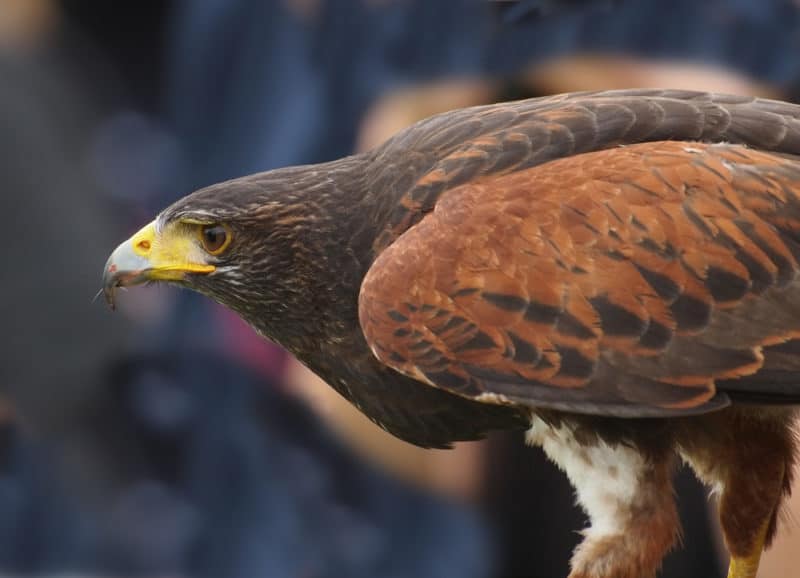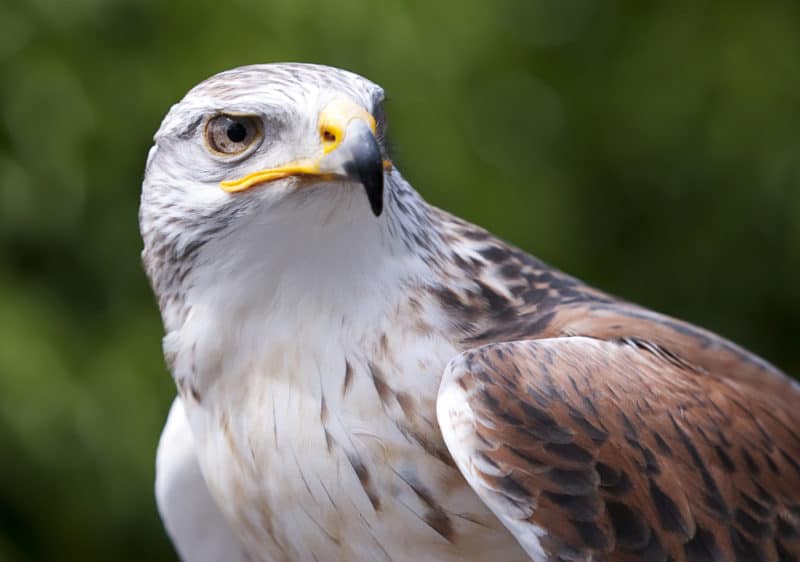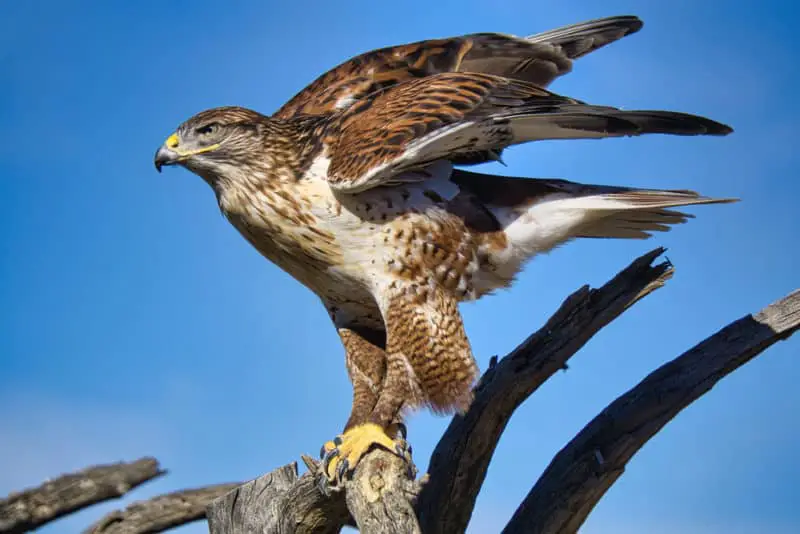Scientific name- ” Buteo regalis ” Their common name, Ferruginous Hawk, is pronounced Fer-oo-jin-ous Hawk.
The Ferruginous Hawk is a member of the Buteo genus, including Red-Tailed Hawks, Rough-Legged Hawks, Zone-tailed Hawks, Red-Shouldered Hawks, Broad-Winged Hawks, Swainson’s Hawks, Broad-winged Hawks, Gray Hawks, and Short-Tailed Hawks in North America.
The Ferruginous Hawk is the largest buteo and the largest hawk in North America. The question, “Is a Ferruginous Hawk an eagle?” is occasionally asked. The answer is no, they’re not eagles, but they’re so large that they’re sometimes mistaken for eagles.
Ferruginous Hawk Characteristics
Ferruginous Hawk Size
As stated above, the Ferruginous Hawk is the largest of the new world buteos. One old-world buteo, the Upland Buzzard of Asia, has a larger average length and wingspan. Ferruginous hawks display moderate sexual dimorphism in size, with females being larger than males. However, there is some overlap in size between larger males and smaller females. Adult Ferruginous Hawks are 20 to 26 inches (50 to 66cm) long. Additionally, the wingspan for a Ferruginous Hawk is 53 to 60 inches (134 to 152 cm) from wingtip to wingtip. Adult birds weigh 2 to 5 pounds (907 to 2268 grams). Source


Ferruginous Hawk Coloration
Males and females are identically marked. The most noticeable difference between the two sexes is in their size. There is a light and dark color morph of the Ferruginous hawk. A light morph bird has rusty brown coloration on its upperparts and a pale grey head, neck, and underparts. They also have a dark streak that extends behind each eye. Their legs are streaked with rust, as are the undersides of their wings. The primary flight feathers of a light morph are dark grey.
Dark morph Ferruginous Hawks are reddish chocolate brown in color.
Other Ferruginous Hawk Characteristics
The legs of a Ferruginous Hawk are feathered down to its talons. Three other North American raptors have feathered legs, and they are as follows.
- Golden Eagles
- Gyrfalcons
- Rough-Legged Hawks
Ferruginous Hawks have a proportionately large yellow beak with a black tip and unusually large mouths. The eyes of these birds are reddish-brown to hazel in color.
Ferruginous Hawk Range
The summer breeding grounds for Ferruginous Hawks lies both in southern Canada and the western United States. The area in Canada where they breed and nest is in southern Alberta and southern Saskatchewan. In the U.S, Washington, Oregon, California, Idaho, Nevada, Utah, Wyoming, Montana, Nebraska, South Dakota, and North Dakota all have summertime breeding populations of these birds. Additionally, there are year-round populations of Ferruginous Hawks in parts of Utah, Colorado, Kansas, New Mexico, and Arizona.
Most northern Ferruginous Hawks migrate between summertime breeding grounds and wintering areas. Consequently, there are wintertime only populations of these birds in California, Nevada, Arizona, New Mexico, Colorado, Kansas, Oklahoma, and Texas. Additionally, some Ferruginous Hawks winter in the Mexican states of Baja California, Baja California Sur, Sonora, Chihuahua, Coahuila, Nuevo Leon, Tamaulipas, San Luis Potosi, and Durango.
Ferruginous Hawk Habitat
Ferruginous hawks are hunters of rodents and other small mammals. Consequently, they prefer the open spaces of western North America, such as grasslands, prairies, the edge lands of pinyon-juniper forests, and sagebrush-covered steppes.
Ferruginous Hawk Diet
These birds eat lagomorphs such as Black-tailed Jack Rabbits, White-tailed Jack Rabbits, and Desert Cottontails. They also eat rodents such as prairie dogs, ground squirrels, pocket gophers, mice, and voles. What’s more, they eat birds such as sage grouse, reptiles, occasional amphibians, and insects. The type of prey they eat varies by geographic location and regional abundance.
In one New Mexico study, Botta’s pocket gophers, Gunnison’s prairie dogs, and Desert cottontail rabbits made up a large portion of Ferruginous Hawks’ diet. The study took place in two areas within the state. One area was unchanged by human civilization, while the other area was partially inhabited by humans. In the partially inhabited area, Ferruginous Hawks’ diet contained a larger percentage of prairie dog and pocket gopher, while in the untouched area, they consumed more desert cottontail. Source
The Ferruginous Hawk uses several different hunting techniques. They like to soar over an area, and scan from a great height, then dive down on their unsuspecting victim. They may also scan an area from a high perch, such as a power pole. At other times they may sweep low over an area to take any unsuspecting prey by surprise.
One other technique that they sometimes employ is to wait at the entrance of their intended prey’s burrow for them to come out. In fact, in the winter, large groups of Ferruginous Hawks will at times congregate in prairie dog towns waiting for the inhabitants to peek out of their holes. These gatherings can become rowdy, with hawks hopping at and threatening each other. The commotion they create will sometimes attract eagles to join in as well. Source
Ferruginous Hawk Predators
Golden Eagles occasionally kill Ferruginous Hawks either as prey or because they are in their territory. When these birds build their nests on the ground, coyotes, bobcats, and raccoons become a threat to raid their nests for eggs and hatchlings.
Ferruginous Hawk Life History
Courtship
Once they have found their mate, Ferruginous Hawks mate for life or until one of the pair dies. The breeding season for these birds runs from March through June.
They have elaborate courting rituals that include circling together with the male performing sky dances where he circles and then dives steeply toward the ground only to climb back up and repeat the process. Mated Ferruginous pairs may also lock talons and beaks as they spiral and tumble end over end toward the ground.
Nest Building
The locations they pick for their nests vary greatly. Solitary trees, cliffs, rock outcroppings, utility structures, shrubs, haystacks, and utility structures are all potential nesting sites. They even build their nests at ground level at times. When they build ground-level nests, they build them on a slope or a hilltop. Source
When they have settled on a suitable nesting site, the male brings in the majority of the materials while the female takes care of the construction of the nest. Materials for their nests include sticks from trees and sagebrush, occasional bones, and plastic and metal refuse. Their nests can be as large as 3 feet tall by 3 feet wide. The female will line the bowl of the nest with soft materials such as bark, sod, or even cow dung.
Nesting
They will lay their eggs any time from April through June. Their clutch size varies from 1 to 8 eggs, with 3 or 4 being the average. The incubation period will last for 31 to 32 days. Incubation duties are shared equally between the male and the female.
Their chicks are born helpless, with their eyes closed, but they develop rapidly. They will be fully fledged in 38 to 50 days. Male chicks fledge earlier than female chicks do. It takes another four weeks for juvenile ferruginous hawks to become completely unrepentant after fledging. However, they begin killing prey within days after leaving the nest. Source They will not reach breeding age until they are two years old.
Life Span
Around 66% of Ferruginous Hawks die within the first year of life, with mortality coming to most of them within the first five years. However, these birds have been recorded to live up to 20 years in the wild. Source
Recent Posts
The only venomous snakes in Washington State are Northern Pacific Rattlesnakes. The Northern Pacific Rattlesnake (Crotalus oreganus oreganus) is a sub-species of the Western Rattlesnake. Anyone...
Skunks are not classified as true hibernators. But they go into a state of torpor when the weather gets cold. Skunks are light sleep hibernators, along with opossums, bears, and raccoons. ...

